Crop Diversity for Human Nutrition and Health Benefits

Crops For the Future (CFF), Jalan Broga, 43500 Semenyih, Selangor Darul Ehsan, Malaysia
Summary
Alongside dramatic increases in crop production over the last 50 years, global food systems have become more dependent on a few major `staple’ crops - just three cereals now provide about 60% of plant-based human energy intake.
There is compelling evidence that diverse diets that include fruits, vegetables, nuts and berries, as well as staples, are instrumental in optimising human health. Many 'forgotten foods’ include ingredients from a wide range of `underutilised’ but locally important crop species.
The contribution of such crops is increasingly being displaced by a globalised diet dominated by major staples. In 2011, a new international organisation, ‘Crops For the Future’ (CFF), was established for research on underutilised crops for food and non-food uses. This paper describes CFF’s research approach and outlines how it is facilitating the wider adoption of underutilised crops and the ‘forgotten’ foods that derive from them.
Background and policy context
Over the last 50 years, many sciences have contributed to the almost 5-fold increase in the production of chicken, 3-fold increase in several cereals (rice, maize, wheat), ocean fish and pig production, and near doubling in the yields of several other crops and animals (Godfray et al., 2010).
While these advances have reduced the proportion of humans suffering under-nutrition, only 15 crops now provide 90% of the world’s food energy intake. Four crops (rice, maize, wheat and soybean) dominate global food systems. The three cereals provide the staple diet of more than four billion people and about 60% of plant-based human energy intake (IPES-Food 2016).
Several recent reports have demonstrated that, while increases in cereal and animal production have satisfied the human needs for carbohydrate and protein, over 3 billion people are affected by malnutrition, caused by either a deficit of essential minerals, dietary essential amino acids and vitamins (‘hidden hunger’) or a surfeit of energy-rich carbohydrates (e.g. IFPRI, 2014; GLOPAN, 2016).
Dependence on a small number of cereal crops has led to increasing concerns about human diets being energy-rich but nutrient-poor (Stadlmayr et al, 2011; Toledo and Burlingame, 2006). Micronutrient deficiencies are now recognised to be more widespread than energy/protein malnutrition with at least 1.5 billion people likely to be affected by one or more micronutrient deficiency (GBD, 2016). The GLOPAN Report (2016) highlights that healthy diets comprise a diverse variety of fruits and vegetables, wholegrains, fibre, nuts and seeds, with limited intake of free sugars, sugary and oil-rich snacks and beverages, processed meats and salt.
Globally, deficiencies in key vitamins and minerals pose a very serious constraint to human health and economic development as detailed by the GLOPAN Foresight Report (GLOPAN 2016). This Report, together with the Global Nutrition Report (IFPRI, 2014), highlights the need for multiple complementary strategies to address key micronutrient deficiencies. Such strategies include: i) food supplementation; ii) food fortification; iii) dietary diversification; and iv) crop biofortification, including breeding and fertilizer-based approaches.
Biofortification of staple crops by selective breeding for zinc and iron content has been successful in several crops and considerable funding is being expended to extend the range of crops and beneficial minerals and compounds (Bouis and Saltzman, 2017). The widespread justification for such an approach is that while the price of staple crops has decreased in recent decades, that of fruit and vegetables has remained constant or increased so that these foods remain relatively inaccessible to the poor.
Nevertheless, many plants contain higher concentrations of vitamins, mineral nutrients and phytometabolites than are found in cereals, and consumption of a diverse range of plants is beneficial to human health (Boedecker et al, 2014). Relying on the biofortification of staple crops also involves risks where such crops may fail to yield as climate changes or becomes more volatile.
Fruits, vegetables and other plants rich in minerals and vitamins can be grown in diverse cropping systems to complement the major crops, thereby improving diets and human health alongside environmental health and sustainability. Smallholder producers in both rural and urban areas frequently grow a mix of crops to enhance their diets and reduce the risk of crop failure.
Women play a vital role in cultivating such crops and as urbanisation increases, the peri-urban production of crops such as vegetables, fruits and herbs increases in importance with the potential to alleviate hidden hunger. Dietary diversification, then, offers a complementary approach to biofortification in improving human diets and ensuring cropping systems that are more resilient in changing climates.
The links between agricultural biodiversity, dietary diversity, human nutritional status and human health outcomes are complex and relatively little researched. Jones (2017) reviewed 23 studies (mostly in Sub-Saharan Africa) that assessed both agricultural and dietary diversity. Overall, he concluded that ‘agricultural diversification may contribute to diversified diets through both subsistence- and income-generating pathways and may be an important strategy for improving diets and nutrition outcomes in low- and middle-income countries’.
However, the magnitude of the association between agricultural and dietary diversity is small and the relationship is not linear. He found that the magnitude depended on the extent of existing diversification of farms, so that increasing biodiversity on farms with low initial biodiversity resulted in larger increases in dietary diversity than the same increase on a farm with high initial biodiversity. Indeed, in the latter case, increasing agricultural biodiversity can reduce dietary diversity because, for example, high agricultural biodiversity may result in less income from specialised cash crops so less money available to purchase diverse foods.
This paper explores research at an international research institution based in Malaysia. Its purpose is to evaluate the potential of currently underutilised crops to contribute to dietary diversification, alleviate hidden hunger and improve human well-being.
Crops For the Future (CFF) and underutilised crops
CFF is the first global research centre dedicated to research on underutilised crops. It was established in 2011 as a research company guaranteed by the Government of Malaysia and the University of Nottingham, Its mission is to develop solutions to diversify agriculture using underutilised crops for food and non-food uses. Having established its headquarters in Malaysia (Figure 1), CFF has developed strategic alliances with over fifty partners.
These include members of AIRCA, the Association of International Research and Development Centers for Agriculture, a consortium of international research and development centres based in four continents. All members of AIRCA are dedicated to agricultural research at the landscape scale – for example, in desert and mountainous regions – or on species such as vegetables and fruits and of insects that are not within the mandates of the CGIAR-funded agricultural system. Research at the nine AIRCA centres is complementary and focused on the diversification of agricultural systems. Through AIRCA, its partners gain access to over 300 locations in 60 countries that serve 70% of humanity. CFF currently chairs AIRCA.
The research strategy of CFF is to enhance ‘the development and production of currently underutilised crops by delivering evidence, knowledge and prototypes of value-added products for public and commercial good’.
Underutilised crops comprise the many species that are overlooked by major research and funding bodies. They include cereals, grains, pulses, fruits, vegetables, flowers, roots, leaves, seeds and nuts. They are often found growing in gardens and on common ground, and may be locally important sources of nutrition and plant remedies that are supported by local, indigenous knowledge.
Some of these species can yield well on soils and in climates that are unfavourable for the production of the staple cereals. For example, several millet species will typically give good yields in dry environments in India and African countries where maize may fail. Even a limited harvest of a diverse range of nutrient-rich species is nutritionally superior to no production of a currently more favoured staple crop.
There are many currently underutilised crops and cropping systems dominated by staples into which they might fit. CFF’s location in Malaysia has allowed it to focus on crops that might complement oil palm (the dominant agricultural land use In Malaysia and significant areas of Indonesia). Despite the abundance of biodiversity in Malaysia, and its surrounding region, this is largely overlooked in favour of the globalised diet based on imported staples. Malaysia is a major importer of foods and raw material for feed.
Agriculture is dominated by the oil palm sector, with very little subsistence agriculture. Opportunities abound for replacing imported ingredients in feed with locally sourced crops and for improving (fortifying) diets with nutritious fruit and vegetable products. Being based in Malaysia does not limit CFF’s research to South East Asia. CFF has a global mandate and has also prioritised research on underutilised crops that fit into the maize-dominated systems of many African countries.
The crops that CFF has initially chosen to focus on are bambara groundnut (Vigna subterranea), moringa (Moringa oleifera), amaranth (Amaranthus spp.), proso millet (Panicum miliaceum) and winged bean (Psophocarpus tetragonolubus). These crops originate in different parts of Africa, Central America and South and Southeast Asia but are grown in pockets in many places in Africa and Southeast Asia (Table 1).
This list is far from exhaustive and will increase as opportunities develop. One of the main strategies of CFF is to provide a ‘blueprint’ for research into the potential of underutilised crops along the value chain, from production through processing to consumption. The selection of these five diverse crops provides a cross section of `exemplar’ cereals (amaranth and millet), legumes (bambara groundnut), tree fruits and green leaves (moringa spp) and a multi-use legume, leafy vegetable and root crop (winged bean).
Bambara groundnut (Figure 2) is the third most important legume in semi-arid Africa and is traditionally known as a woman’s or poor man’s crop. It is very drought tolerant and can yield on poor soils when other crops fail. The seeds contain up to 60% carbohydrate, 16-20% protein and 6-8% oil and are a rich source of minerals and essential amino acids (Brough and Azam Ali, 1992).
In parts of Africa the seeds are ground into flour and used to partially replace other cereals in breads and baked products, while in Southeast Asia they are mostly consumed unprocessed. The seeds are very similar in composition and functionality to the leguminous chickpea (Cicer arietinum), which is incorporated into many food products (extruded chips, flours, cookies). There is potential for bambara groundnut to be used in a similar way.
Moringa (Figure 3) is native to the Indian Himalayas but now grows throughout the dry and lowland tropics. It is grown primarily for its nutrient rich leaves and pods and has been promoted as a ‘miracle tree’ because of the many nutritional and health benefits claimed for it.
The leaves are reported to be good sources of vitamins A ( carotene), B and C and of several minerals including calcium, potassium, magnesium, iron and zinc (Olsen et al., 2016). There have been few systematic studies of the differences in nutrient concentrations of leaves across the genus or grown under different conditions although a study of dried leaves showed two- to three-fold differences in calcium and potassium concentrations (Olsen et al., 2016). Moringa leaves can add nutritional value to diets simply by adding them to starchy staple cereals.
Amaranth (Figure 4) is a genus of about 60 species that is grown for either grain (especially in Central America and parts of Africa) or as a leafy vegetable (Southeast Asia). It is of interest because of the high nutritional value of the seeds, its resistance to drought and because of its short growing period.
Compared to staple cereals, its seeds are high in protein and dietary fibre, and contain five to twenty times as much iron and calcium and twice the lysine (Venskutonis and Kraujalis, 2013). Amaranth grain is valued for its lipid content (range 4.8 to 19.3% depending on species and growing conditions) and for the content of the essential amino acids lysine and tryptophan. The grains can be milled for bread and biscuits and the leaves used in soups and salads.
Proso millet (Figure 5) is one of the oldest cereals consumed by humans and is drought tolerant. As with amaranth, it has a short growing period. It lacks the protein gluten, but the total concentration of proteins is similar to that in wheat (about 11-12%).
Winged bean (Figure 6) is a perennial climbing plant originating in Papua New Guinea but now grown throughout parts of Southeast Asia and Sub-Saharan Africa. All parts of the plant are edible (including the tuberous roots), but it is typically grown as an annual for its pods. The seeds are a rich source of oil (up to 17%), vitamin E and calcium (Reddy, 2015). In Southeast Asia the pods are cooked and eaten as a vegetable.
A notable feature of these five crops, and of other underutilised crops, is that there is only limited information available regarding their nutritional contents and benefits. It is rare to find a full description of carbohydrates, proteins, fats, minerals, vitamins, amino acids, phytochemicals and anti-nutritional factors for a single crop.
This, in turn, has fuelled advocacy for particular ‘miracle’ or ‘super’ plants rather than evidence-based assessments of potential (see, for example, Thurber and Fahey, 2009). The lack of comprehensive data also means that it is difficult to assess the effects of provenance and growing conditions on the nutritional value of crops.
A key feature of research at CFF has been to adopt a food system approach to identify the major factors influencing nutritional, and other desirable qualities, of underutilised crop species along the value chain. This `Connect’ approach enables research to explore the comparative potential of underutilised species to provide nutritious foods.
An example of this approach is a current project that is following the changes in nutritional quality of two crops (bambara groundnut and moringa) from their growth in the field through harvest, drying, milling, storage and their incorporation into foods such as biscuits and soups (Figure 7). This food system approach has also led to the development of crop processing techniques and the production of innovative foods for human consumption (Figure 8).
Aquaculture is an important component of food systems in Southeast Asia, but the use of fishmeal to feed fish is unsustainable. Research is currently underway to introduce omega-3 long chain polyunsaturated fatty acids into crops to replace fishmeal (Tocher et al., 2015). CFF is pioneering a different approach that uses currently underutilised crops such as sesbania (Sesbania grandiflora) and leucaena (Leucaena leucocephala) as feed substrate for the larvae of black soldier flies.
The adult larvae replace a proportion of the fishmeal in diets fed to fish. By manipulating the substrate for feeding larvae through the inclusion of a range of underutilised crop species, the nutritional composition of larvae can be improved allowing them to replace fish meal. Small-scale pilot studies have produced encouraging results (Figure 9), which are now being scaled up.
From Research to Practice
Whilst there is some published information on the nutritional value of underutilised crops, very little is known about the impacts of varietal and environmental differences and agronomic practice, or of processing and storage, on changes in the nutritional value of their products.
Ongoing pilot research projects with moringa and bambara groundnut aim to follow the fate of nutrients through the food system from growing through processing and storage to production and consumption of food products. Simultaneously, consumer sensory evaluations of the developed food products are being undertaken, together with an assessment of the openness of consumers to novel foods.
The products selected for development were bambara groundnut biscuits and dried moringa soup (Figure 7), both of which are suitable for production at a small-scale, creating income opportunities for producers and processors. They are also suitable for scaling up into commercial production for mainstream and niche markets, should the demand be created.
Whilst the project has provided much needed information on the potential for these two crops to partially replace wheat and maize in a range of foods, and to nutritionally fortify a range of staple foods, it has also been instrumental in identifying major constraints which must be addressed prior to greater adoption.
A key constraint to the increased utilisation of these two crops is the lack of appropriate post-harvest technology for the shelling and milling of bambara groundnut and for stripping the moringa leaflets from the stem prior to drying. These problems are not insurmountable – rather, they provide interesting options for the development of appropriate machinery to improve processing. A prototype bambara groundnut shelling machine has been developed by partners to address one of these problems (Figure 8).
This study has also highlighted the need for a coherent action plan that extends beyond the value chain of production to consumption. If underutilised crops and their products are to become more widely utilised on a global scale, they have to be produced in the substantial quantities that are required by processors (in future climates), and, very importantly, there have to be market outlets for both the crops and their products.
Farmers require genotypes that are adapted to local agro-climates. This is increasingly important in changing climates - crops that currently yield well in today’s climate may not thrive in the hotter climate of the future. CFF is developing a knowledge base for underutilised crops that can be used as a predictive tool by farmers who are looking for new crops with which to diversify their agriculture and diets, and by breeders wishing to select parents for crossing. CFF is actively selecting and breeding genotypes of Bambara groundnut that are adapted to southeast Asian (Malaysian) and African conditions
Access to viable markets is critical to the mainstreaming of underutilised species and for them to play a major role in dietary diversification. Food manufacturers require assurance both that the raw materials can be supplied in quantities greater than those available from research farms; and that the products they make will be acceptable to consumers. With the increased consumer awareness of the links between diet and health, a growing interest in novel foods, and the search for the latest superfood, convincing consumers to change their behaviour, is perhaps less of a challenge than ensuring a plentiful supply of the raw material.
Another issue to be addressed is how currently underutilised crops, mainly grown by small-scale subsistence farmers, can be developed to provide an income via either local, national or international markets. Experience suggests that multinational corporations are not suitable for this task, but that small- and medium-sized companies with an interest in producing food for local and national markets may provide a way forward.
Growing interest in ‘artisan foods’, sustainable consumption through the increased use of local and seasonal foods, and a revival of local food heritage offer potential outlets for increased utilisation of underutilised crops. To build on this interest, CFF has recently launched the `Forgotten Foods Network’ (http://www.forgottenfoodsnetwork.org) a website that curates recipes and knowledge about forgotten foods from around the world.
Policy requirements
There is already compelling evidence to suggest that diets that include diverse fruits, vegetables, nuts and berries in addition to cereals and other staples are either required or essential for complete human health. Policies are, therefore, required to ensure that this diversity is effectively exploited for the benefit of all – particularly the rural and urban poor. Achieving this goal is challenging.
For example, increased global consumption (especially in developed nations) of the ‘superfood’ quinoa has meant that the subsistence farmers who grow the crop are no longer able to afford to consume it. Likewise, small-scale cocoa growers only receive around 1-2% of the value of the finished chocolate product.
Much of the literature on the potential health benefits of consuming (currently) underutilised plant foods is anecdotal rather than evidence-based. To provide a credible evidence base requires a concerted research effort and investment in these neglected species.
Investment in infrastructure across the food system is required to support the production, processing and marketing of underutilised crops. Small-scale, peri-urban and subsistence farmers require encouragement to produce more of these species and to use them to partially replace or complement cereals and animal-based foods.
A concerted research effort is needed to examine and analyse the proximate composition of crops/plants/species produced under a range of agroclimatic conditions. This will also need to include varietal differences, and the impacts of processing and storage on nutritional value. Consumption of a diverse range of whole plant foods, rather than the extracted phytochemicals, can provide a range of additional nutritional benefits. These links between plant-based diets and reduced incidence of cancer and cardiovascular diseases require further investigation.
For underutilised species to play a more significant role in dietary diversification and nutritional security, it is essential to include capacity building for all stakeholders involved in the value chains. This includes farmer associations, other private sector players including the seed industry, national government and non-government research and advisory bodies, extension workers, health workers and the general public who will be the consumers of diverse and healthy diets.
Finally, the warmer and more volatile climates of the future may render dependence on a very few plant species to appear very short-sighted.
References
Boedecker, J., Termonte, C., Assogbadjo, A.E., Van Damme, P. and Lachat, C. (2014). Dietary contribution of wild edible plants to women’s diets in the buffer zone around the Lama forest, Benin – an underutilised potential. Food Security 6: 833-849.
Bouis, H.E. and Saltzman, A. (2017). Improving nutrition through biofortification: A review of evidence from HarvestPlus, 2003 through 2016. Global Food Security 12: 49-58.
Brough, S.H and Azam-Ali, S.N. (1992). The effect of soil moisture on the proximate composition of Bambara groundnut (Vigna subterranea (L) Verdc). Journal of the Science of Food and Agriculture 60: 197-203.
GBD, 2016. Mortality and Causes of Death Collaborators. Global, regional, and national life expectancy, all-cause mortality, and cause-specific mortality for 249 causes of death, 1980–2015: a systematic analysis for the Global Burden of Disease Study 2015. Lancet 388: 1459–1544.
GLOPAN (2016). Food systems and diets: Facing the challenges of the 21st century. Global Panel on Agriculture and Food Systems for Nutrition. London, UK.
Godfray, H.C.J., Beddington, J.R., Crute, I.R., Haddad, L, Lawrence, D, Muir, J.F., Pretty J, Robinson, S., Thomas, S.M. and Toulmin, C. (2010). Food Security: The Challenge of Feeding 9 Billion People. Science 327: 812-818.
IFPRI (International Food Policy Research Institute) (2014). Global Nutrition Report 2014: Actions and Accountability to Accelerate the World’s Progress on Nutrition, Washington DC.
IPES-Food. 2016. From uniformity to diversity: a paradigm shift from industrial agriculture to diversified agroecological systems. International Panel of Experts on Sustainable Food systems.
Jones AD (2017). Critical review of the emerging research evidence on agricultural biodiversity, diet diversity, and nutritional status in low- and middle-income countries. Nutrition Reviews 1-14.
Olsen, ME., Sankaran, R.P., Fahey, J.W., Grusak, M.A., Odee, D. and Nouman, W. (2016). Leaf Protein and Mineral Concentrations across the ‘Miracle Tree’ Genus Moringa. PLoS ONE 11(7): e0159782.
Reddy, P.P. (2015). Winged bean (Psophocarpus tetragonolobus). In: Plant protection in tropical root and tuber crops. Springer 293-303.
Stadlmayr, B., Nilsson, E., Mouille, B., Medhammar, E., Burlingame, B. and Charrondiere, R. (2011). Nutrition indicator for biodiversity on food composition – A report on the progress of data availability. Journal of Food Composition and Analysis 24: 692-698.
Tocher, D.R., Napier, J.A., Betancor, M.B., Sayanova, O., Haslam, R.P. and Usher, S. (2015). The supply of fish oil to aquaculture: a role for transgenic oilseed crops? World Agriculture: paper 1509.
Toledo, A. and Burlingame, B. (2006). Biodiversity and nutrition: A common path toward global food security and sustainable development. Journal of Food Composition and Analysis 19: 477-483.
Thurber, M. and Fahey, J.W. (2009). Adoption of Moringa oleifera to combat under-nutrition viewed through the lens of the “Diffusion of Innovations” theory. Ecological Food Nutrition 48: 212-225.
Venskutonis, P.R. and Kraujalis, P. (2013). Nutritional components of amaranth seeds and vegetables: a review on composition, properties and uses. Comprehensive Reviews in Food Science and Food Safety 12: 381-412.
Download pdfFigures
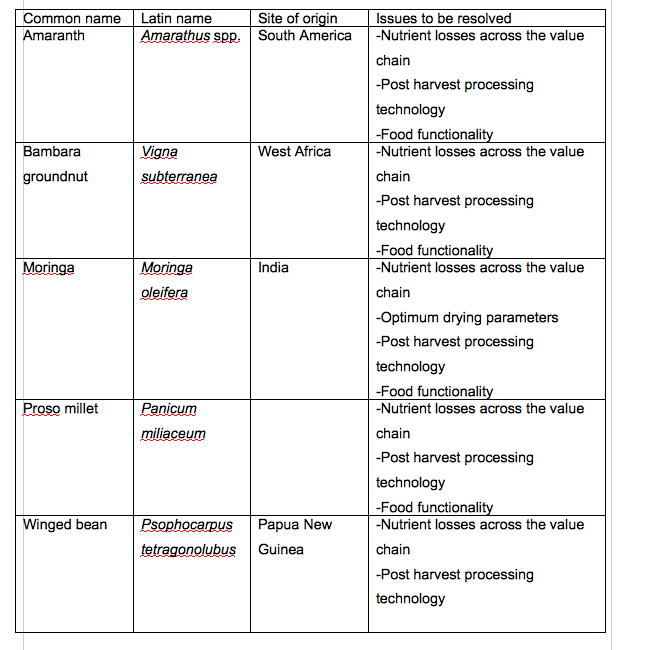
Table 1 A selection of underutilised crops that are the subjects for research at CFF

The CFF headquarters near Kuala Lumpur,
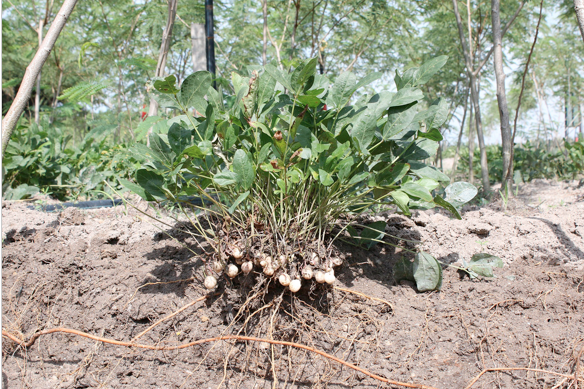
Bambara groundnut showing the pods which form just below the soil surf
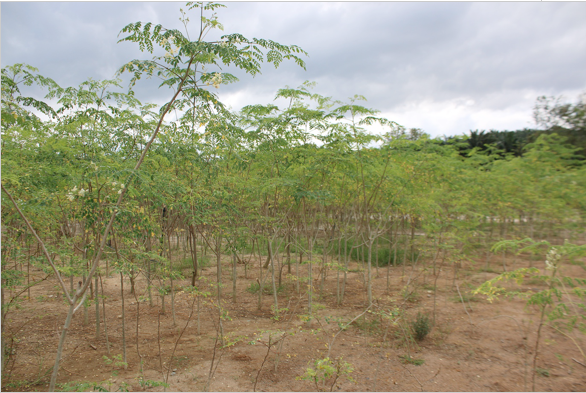
Young trees of moringa being grown for their leaves
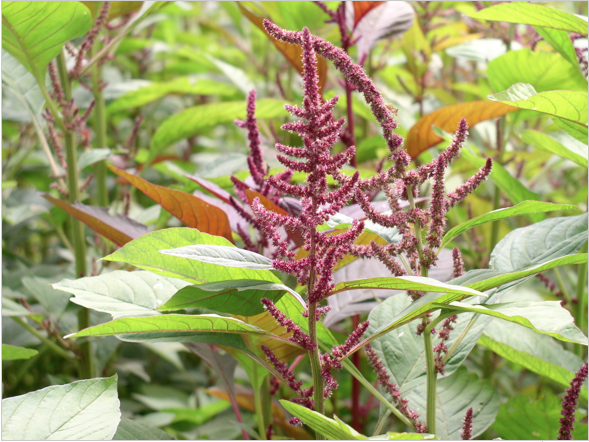
Amaranth growing in Kenya for harvest as grain
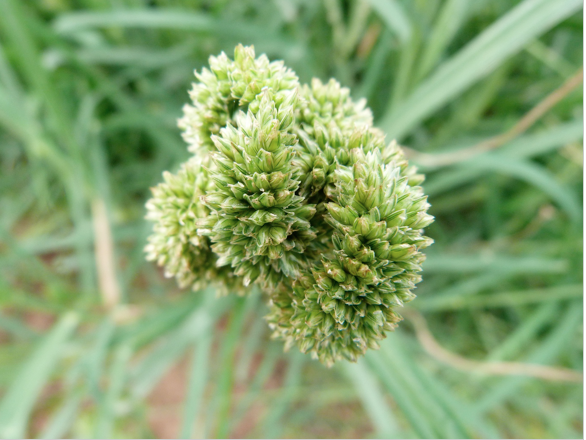
The inflorescence of Proso millet with grains growing
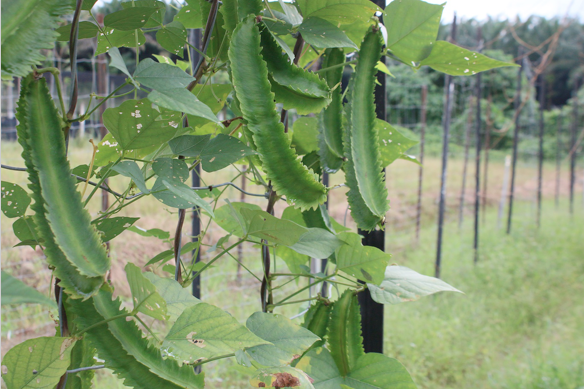
Winged bean growing against a framework at the CFF Field Research Centre

Two ‘new’ foods developed from underutilised crops by CFF a) biscotti containing bambara groundnut and b) moringa soup

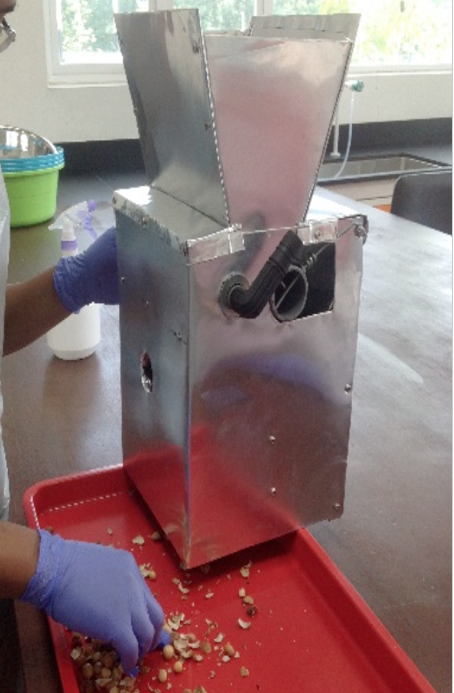
A prototype machine used at CFF for removing the shells of bambara groundnut
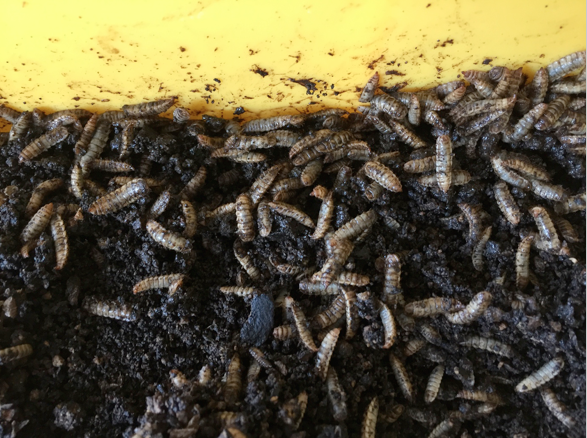
Black soldier fly larvae grown on a combination of sesbania and bambara groundnut leaves for feeding to fish

